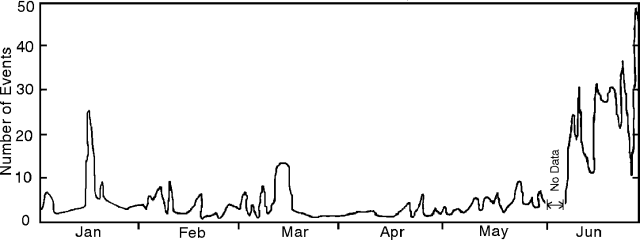Report on Poas (Costa Rica) — June 1994
Bulletin of the Global Volcanism Network, vol. 19, no. 6 (June 1994)
Managing Editor: Richard Wunderman.
Poas (Costa Rica) Weak ashfalls of fine evaporitic sediments and continuous tremor on 5 days
Please cite this report as:
Global Volcanism Program, 1994. Report on Poas (Costa Rica) (Wunderman, R., ed.). Bulletin of the Global Volcanism Network, 19:6. Smithsonian Institution. https://doi.org/10.5479/si.GVP.BGVN199406-345040
Poas
Costa Rica
10.2°N, 84.233°W; summit elev. 2697 m
All times are local (unless otherwise noted)
The lake in the active crater remained dry or nearly dry during June despite two months of rainfall. On the S and SW parts of the lake floor there appeared new fumaroles equal in size to those in the W and NW. Some fumaroles were yellow and reddish in color. A strong level of degassing continued, creating columns that rose to over a kilometer above the lake floor. Escaping gases caused jetting sounds heard from the crater overlook. During June, the wind predominantly carried the gases toward the W and SW, but occasionally to the S as well. The acidity of the windblown gases caused damage to local vegetation.
At 1800 on 3 June, witnesses watched a phreatic eruption column grow 2-km tall over about a 10-minute interval. The dark gray column attained a mushroom-shape. The next day, fine non-juvenile ash was found along the E border of the crater (at Laguna Botos, the hut at the National Park entrance, and on Cerro Pélon).
On 17 June, the S lake area had the morphology of a shallow pan. This area constantly bubbled and ejected phreatic clouds that rose up to 20-m height. A week later, however, activity at this active vent area ceased. A decrease in the lake level on 23 June exposed a gray deposit and blocks displaced by the previous pheatic eruption.
La Nacion newspaper reported that on 8 July a weak ashfall affected some villages at the southwestern foot of the volcano. ICE researchers described the material as fine evaporitic sediments formed by desiccation of the lake during an abnormal dry season last year. ICE researchers also reported the temperatures of steam-rich fumaroles on the dome up to 89°C.
Intermediate-frequency (type AB) earthquakes at Poás grew in June, averaging roughly 10x the background seen earlier in the year (figure 51). Some equipment failures took place in early June, but available data indicated that low-frequency seismicity (figure 52) averaged 228 events/day, giving a projected tally of 6,840 events for the month. This is close to the number of low-frequency events seen in March and April, the most seismically active months of the year. During June, tremor duration was highly variable, but on 5 days tremor took place continuously and on six other days it prevailed for >18 hours/day (figure 52). Tremor had amplitudes of >4 mm, but during the intervals 9-17 and 23-29 June it attained amplitudes >5 mm and fell in the 1.3-2.5 Hz range.
 |
Figure 52. Low-frequency seismicity (top) and tremor duration (bottom) at Poás, June 1994. Courtesy of OVSICORI. |
Poás, one of the most active volcanoes of Costa Rica, is broad and well-vegetated, with a summit area containing three craters. Several months ago two of these craters held lakes. One lake still persists and contains clear water. The other lake was colored and occupied the active crater, but it has recently receded. Disappearance of the lake in the active crater appears to be associated with increased eruptions and sub-aerial emissions of harmful acidic gases.
Geological Summary. The broad vegetated edifice of Poás, one of the most active volcanoes of Costa Rica, contains three craters along a N-S line. The frequently visited multi-hued summit crater lakes of the basaltic-to-dacitic volcano are easily accessible by vehicle from the nearby capital city of San José. A N-S-trending fissure cutting the complex stratovolcano extends to the lower N flank, where it has produced the Congo stratovolcano and several lake-filled maars. The southernmost of the two summit crater lakes, Botos, last erupted about 7,500 years ago. The more prominent geothermally heated northern lake, Laguna Caliente, is one of the world's most acidic natural lakes, with a pH of near zero. It has been the site of frequent phreatic and phreatomagmatic eruptions since an eruption was reported in 1828. Eruptions often include geyser-like ejections of crater-lake water.
Information Contacts: E. Fernández, J. Barquero, R. Van der Laat, F. de Obaldia, T. Marino, V. Barboza, and R. Sáenz, OVSICORI; G. Soto, G. Alvarado, and F. Arias, ICE; H. Flores, UCR.


